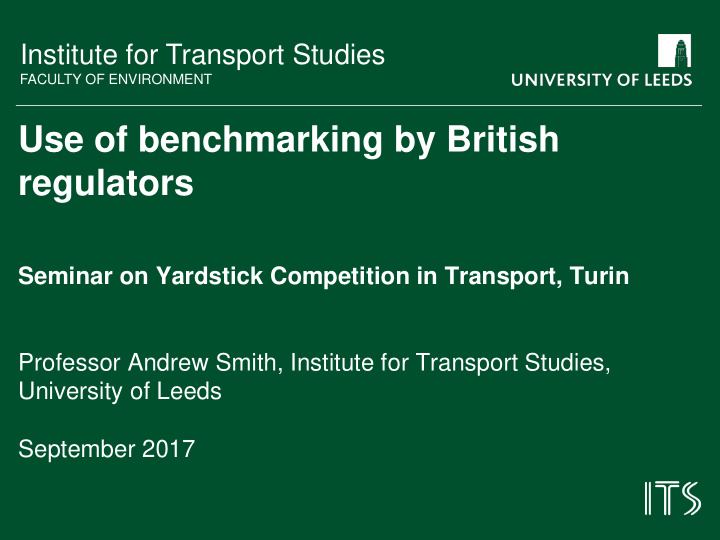



Institute for Transport Studies FACULTY OF ENVIRONMENT Use of benchmarking by British regulators Seminar on Yardstick Competition in Transport, Turin Professor Andrew Smith, Institute for Transport Studies, University of Leeds September 2017
RPI-X regulation RPI-X regulation has been credited with achieving very significant unit cost reductions in the UK Efficiency benchmarking – or yardstick competition - is a key input into setting the X factor Price change = RPI - X Input price trends Expected productivity gain E.g. RPI-1 RPI-2 RPI-5 Scale effects Efficiency gains Technological progress
Yardstick Competition Conceptual Approach • Regulator eliminates inter-company efficiency differences . Step 1: catch-up A Cost . . E Cost frontier (T=0) B D . Cost frontier (T=5) Step 2: frontier shift . C Data points can be regulated firms in same country, or different countries (or different zones within Output a company)
Example: Rail International benchmarking study • Panel data:13 European countries over 11 years • Used by International Union of Railways (UIC) in its benchmarking • Standard definitions – to an extent Cost Data Network Size Final Outputs Network Characteristics Maintenance Track kilometres Passenger train Ratio of single track to route costs Route kilometres kilometres kilometres (as a measure of the extent of single / Total costs Single track Passenger tonne multiple track) (Maintenance + kilometres kilometres renewals) Proportion of track Electrified track Total tonne kilometres electrified kilometres Freight train kilometres Number of stations per route km Freight tonne kilometres Number of switches per track km Total train kilometres
Efficiency estimates for Network Rail Profile of Network Rail Efficiency Scores: Flexible Cuesta00 Model 1 0.9 40% 0.8 gap 0.7 Score against frontier 0.6 0.5 0.4 Speed of 0.3 adjustment? 0.2 0.1 0 1996 1997 1998 1999 2000 2001 2002 2003 2004 2005 2006 Implies a gap against the frontier of 40% in 2006
Regulatory challenges • Do we believe the model? Will the companies accept it? Eg. CMA enquiry in 2015;17 of 18 water companies accepted; 1 appeal Engineering / management evidence? Do different methods and specifications produce similar results? • Time consuming to collect data set – long-term commitment • Modelling fundamental differences in characteristics and quality of railways • Understanding uncertainty in efficiency modelling • How to deal with lumpy / cyclical capital costs?
Lumpy capex renewals – rail (whole network) Rail Renewals 2007 to 2013 1400 1200 1000 800 600 400 200 0 2007 2008 2009 2010 2011 2012 2013
Lumpy capex renewals – water (industry) Water sector renewals 2007 to 2013 5,000.0 4,500.0 4,000.0 3,500.0 3,000.0 2,500.0 2,000.0 1,500.0 1,000.0 500.0 0.0 2007 2008 2009 2010 2011 2012 2013 • There are solutions to this problem though they are not perfect…
Regulatory approaches to uncertainty • Range 13-24% • Ignoring the extremes would suggest a gap of 23% (ORR) • Bottom-up engineering methods now starting to dominate though in rail regulation in Britain • 16% for maintenance; 20% for renewals • Source: Office of Rail Regulation (2013)
Concluding remarks • Britain: multiple decades of experience of economic regulation of privatised (and non-profit / state-owned) firms • Cost benchmarking, combined with high powered incentives, credited with achieving substantial productivity gains • Critical success factors? • Good quality data; common definitions between firms; over time • Appropriate cost efficiency model / use of multiple models • Supporting evidence from business plans and bottom-up studies • Use of regulatory judgement e.g. on speed of adjustment and special factors • Transparency and communication – esp. in GB system
Recommend
More recommend